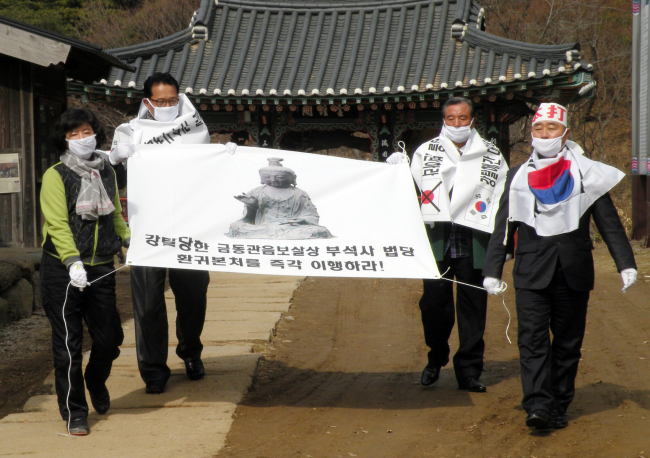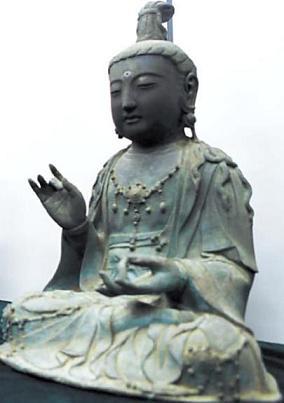Is a stolen cultural asset, which had been previously looted from the country, subject to repatriation?
The answer seems to be not so clear-cut with the Foreign Ministry in Korea reviewing the issue of repatriation of an ancient Korean Buddhist statue stolen from a Japanese temple.
The police in late January announced the arrest of five Koreans in a theft ring who tried to sell two ancient Korean Buddhist statues that had been stolen from Japan months earlier.
“The government is holding an internal review of how to resolve this issue based on domestic laws concerning the protection of cultural heritage and the UNESCO conventions on cultural heritage,” said a Foreign Ministry vice spokesperson during a regular press briefing on Thursday.
 |
A South Korean civic group calls for the return to Buseoksa Temple of an ancient Korean Buddhist statue stolen from a Japanese temple during a rally held at Buseoksa Temple, South Chungcheong Province, Thursday. (Yonhap News) |
 |
Geumgdong Gwaneum Bosal (Yonhap News) |
Last Wednesday, Japan’s Chief Cabinet Secretary Yoshihide Suga urged the Korean government to return the Bodhisattva statues that were stolen and smuggled into Korea. “We will call for the speedy return through diplomatic channels and in accordance with international law,” he was quoted by Kyodo News as saying.
This came a day after the Daejeon District Court ruled in favor of Buseoksa Temple in South Chungcheong Province which had filed for a temporary injunction against the transfer of one of the statues. The court said that the Geumdong Gwaneum Bosal statue, believed to have been created in 1330 and stolen by Japanese pirates around 1370, should not be returned to Japan until the origin of the statue is verified and it can be shown that the Kannonji Temple in Tsushima, Nagasaki Prefecture, acquired it in a lawful process. Buseoksa Temple did not file an injunction for the other statue, believed to have been made during the eighth-century Silla Kingdom’s rule.
Buseoksa Temple claims that the artifact was illegally removed from the temple more than 700 years ago and should be returned to the Buddhists. There are two grounds for the allegations: The place of origin (Buseoksa Temple) and the time of manufacture (1330) are inscribed on the statue.
Secondly, numerous academic reports show Japanese pirates’ taking away of valuable cultural assets from Korea around that time, and the statue is believed to have been among the looted items, said Hwang Pyung-woo, the head of the Korean Cultural Heritage Policy Institute. “There is a document showing that the Japanese took the statue in question from Korea, not being offered as a gift, which clearly indicates illegality.”
The statues came under media spotlight on Jan. 29 when local police announced the arrest of a group of thieves who had allegedly smuggled the two artifacts from Kisaka Kaijin Shrine on Tsushima Island.
The Cultural Heritage Administration initially stated that the stolen items will be returned to Japan. However, the revelation of the origin of the pieces has fueled calls against the return of the artifacts among Buddhists and civic groups. CHA has recently formed an investigative body to verify the suspicions.
Civic groups expect the case to set an example for the repatriation of many more cultural assets in the future. The UNESCO Convention Against Illicit Export allows for stolen objects to be seized if there are documentations of it in a museum or institution of a state party.
According to the National Research Institute of Cultural Heritage, a total of 66,295 pieces of “plundered” cultural assets are believed to be kept in Japan, while 42,293 are in the U.S., 10,792 in Germany and 8,225 in China, among other countries. But only 9,749, or 6.5 percent, have been repatriated so far.
Hwang suggested that the two governments agree to keep the artifacts in a third-party institution or country while it is being examined and studied. “Once the study wraps up and the truth is unveiled, we will talk about repatriation,” he said.
By Bae Ji-sook (
baejisook@heraldcorp.com)






![[Exclusive] Hyundai Mobis eyes closer ties with BYD](http://res.heraldm.com/phpwas/restmb_idxmake.php?idx=644&simg=/content/image/2024/11/25/20241125050044_0.jpg)
![[Herald Review] 'Gangnam B-Side' combines social realism with masterful suspense, performance](http://res.heraldm.com/phpwas/restmb_idxmake.php?idx=644&simg=/content/image/2024/11/25/20241125050072_0.jpg)

